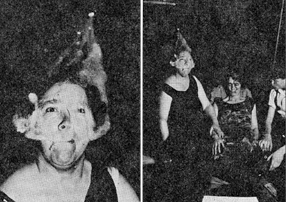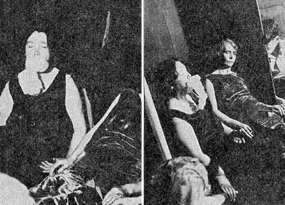|
SO far we have considered only examples of teleplasm connected directly with the medium's body. Now we will examine certain plasms which were separated from Dawn. From the point of view of magnitude these plasms were among the most spectacular which the group mediumship produced.
The first of these independent forms was the "Lucy" mass of March 10, 1930, the same year in which were recorded four additional plasms, externalized and located on the back wall of the cabinet. Two independent teleplasms per year were produced in 1931, 1932, 1933; that is to say, eleven masses, or roughly
one-fifth of the total number of all plasms occurred at a distance from, or independently of the medium. This relatively small percentage we regarded as an indication that plasms of this independent type were less easily produced than those which showed a connection with some part of Dawn's body.
 |
| Plate 28a: Two views
of the 'umbrella' teleplasm of February 25, 1934. |
 |
| Plate 28b: Two views
of the mass of February 25, 1934, after an elapsed time of four minutes.
Dawn, Mercedes, Norman all deeply entranced. |
There is no direct experimental evidence to indicate why these independent plasms should have been more difficult to produce. We can only guess at possible reasons. In some cases such masses were clearly seen to be dependent from the flat vertical surface of the cabinet wall, implying some manner of adhesion to the wood. This in itself may have presented difficulties to the trance operators. Also, there must have been the problem of transferring the material itself from Dawn to the new site. This we inferred from Walter's statement that during the preliminary sittings he gathered part of his material and stored it in the wood of the cabinet. And at those sittings where he claimed to be building a materialization, he sometimes insisted on the medium's hands being freed; when this was done, she would rub the cabinet wood vigorously with her fingertips. It is inconceivable that such a process of storing and externalizing energy, if it exists at all, could be as efficient as the relatively simple process of exteriorization from or near the medium's head or body.
Now shown are two plasms whose major bulk was located at a distance from the medium, at the same time demonstrating a tenuous connection with her body.
Plate 28a shows the 'umbrella' teleplasm of February 25, 1934, one of the last which Dr. Hamilton photographed. It is a
cone-shaped structure extending from the medium's mouth to a point on the cabinet wall above and behind her head, a distance of more than two feet. It displays an extremely thin network of fibres. The apex is compacted to form a
button-like shape by which the mass appears to be attached to the wall. This 'button' formation was found to be common to other plasms also located on the cabinet wall. Plate 28b, taken four minutes after Plate 28a, shows that the mass had left the wall and had partially receded into the medium's mouth. This withdrawal had resulted in a gathering and thickening of the material, but the indefiniteness of the outlines indicates that the fibres had retained their individuality. A final exposure, taken three minutes after the second exposure, showed no sign of the substance.
 |
| Plate 29: The
face-bearing teleplasm of December 20, 1933. |
The trance entities had accurately directed the photography, but their description of the mass itself was incorrect. The Ewan control had said that it would be a differentiated mass.
The second plasm - separated from Dawn - appeared on December 20, 1933. "Norman", a young man who had joined the group in September 1933, and who had developed as an auxiliary medium, gave the signal for the exposure. This plasm is shown here since it too supports the theory that all plasms had their source in Dawn. A thin cord is visible, which passes between the back of Dawn's chair and her left shoulder, becoming thicker and rising to a considerable height on the cabinet wall above Mercedes, seated at Dawn's left. This cord is likely a channel of supply to the
face-bearing mass. While this is slender evidence, it is in line with the obvious requirements which demand that these plasms show properties similar to those of the earlier masses exteriorized on Dawn's body. The only difference is this
- that the wood presumably plays a part in storage and support of the material.
 |
| Plate 30: The
manipulated teleplasm of June 10, 1931. |
One of the most impressive and decisive examples of manipulated teleplasm is seen in Plate 30. Here the substance has been formed into clear capital letters spelling the name FLAMMARION. All serious students of psychical phenomena know that Flammarion, the noted French astronomer, had been a
life-long investigator of psychic events, and that he had written several books describing his researches. What is less well known is that our first medium Elizabeth M. often described him clairvoyantly, and that he had indicated his presence from time to time through her
trance-visions and writings. None of the controls, least of all Walter, pressed the obvious inference. In fact, Walter modestly suggested that Dr. Hamilton use only one camera, explaining:
"I have written a name on the back of the cabinet and I want you to take a flash to see if it came out all right. I think one camera would be sufficient. It is not at all important. I meant it for an experiment that I am doing and I want it done quickly." June 10,
1931.
|

